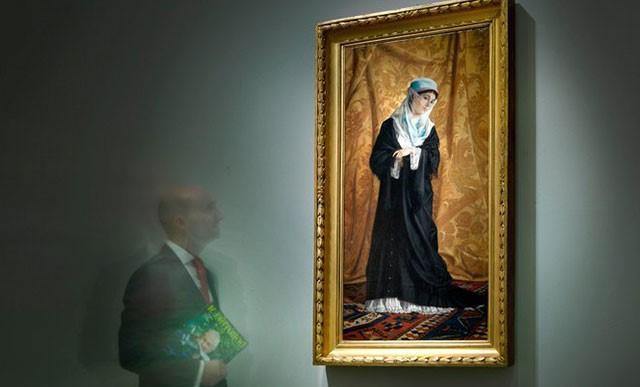
Scientific research and conservation studies of six paintings by Osman Hamdi Bey, kept in the Sabancı University Sakıp Sabancı Museum Painting Collection, have been moved to the Google Arts & Culture platform, one of the most important digital platforms of the culture and arts world.
The research, also the source of the exhibition titled “Osman Hamdi Bey Beyond Vision,” which can be visited at Atlı Köşk since June 6, 2018, was opened to international access.
The online exhibition, which can be visited with Turkish and English language options, provides detailed information on the techniques and material structures of the works attributed to Osman Hamdi Bey, as well as making scientific methods understandable to know more about the production of an artist.
The project, which comparatively studies the artist’s paintings “ Flowers in a Vase” “Hodja Reading the Qur’an,” “Kokona Despina,” “Portrait of Naile Hanim,” “Petitioner” and “The Mosque,” creates a road map not for the conservation work not only in Turkey, but also in the world.
The “Scientific Analysis and Conservation of the Osman Hamdi Bey Paintings,” which are the source of the exhibition, was initiated in 2016 within the scope of the Bank of America Merrill Lynch’s international “Art Conservation Project.” This is the most detailed study on Osman Hamdi Bey paintings in the world.
The first step of the project consisted of subjecting the paintings to X-ray imaging to reveal Osman Hamdi Bey’s work technique and the paintings’ present condition. This was followed by the chemical analyses of the elements of the paintings. The micro samples taken were embedded in capsules with epoxy to preserve their characteristics and analyzed with the SEM-EDS (scanning electron microscope with energy-dispersive X-ray spectroscopy) technique to determine the structure, colors, paint layers and texture of the materials used by the artist and the elements contained.
“Fingerprint” graphs of the paints were revealed with the Raman spectroscopy, and the pigments constituting them were discovered. Finally, the organic structure of the six paintings was analyzed with FTIR (Fouriertransform infrared spectroscopy) and the data was classified through the PCA (primary component analysis) method to determine their characteristics.
The project revealed the types of pigments frequently used by the artist as well as details regarding his paint application technique which are not visible to the naked eye. The hard and soft brushstrokes in his paintings were uncovered and information on the work he conducted on the canvas before he started painting was obtained.
Within the context of the project, the present condition of the paintings was also determined and conservation work completed. Arguments about the artist’s meticulousness in the use of materials, preference for materials which were relatively expensive in his time, the detailed work he conducted before painting were scientifically confirmed. The discovery of details not visible to the naked eye formed a basis for the reevaluation of Osman Hamdi Bey’s paintings in the Sakıp Sabancı Museum Collection from the art history perspective.
In the project, which was carried out with the collaboration of Sakıp Sabancı Museum, Sabancı University, Koç University and Istanbul Technical University, the Getty Conservation Institute also provided consultancy for the evaluation of the test results.
The project’s scientific consultancy was carried out by the Danish Museums Joint Conservation Center Painting Conservation Specialist Filiz Güçlü. The science committee included SSM Painting Collection Manager Hüma Arslaner, SSM Conservation Laboratory Manager Nurçin Kural Özgörüş, Getty Conservation Institute Chemistry Expert Lynn Lee, Sabancı University Faculty of Engineering and Natural Sciences Materials Science and Engineering Program Professor Mehmet Ali Gülgün, Meltem Sezen and Feray Bakan of Sabancı University Nanotechnology Research and Application Center SUNUM.